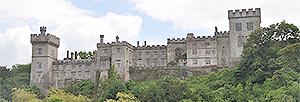
Fishing at Bolton Abbey
16/05/2024
Location, Location, Location!
06/08/2024Of all the artists, the one who always delivers and still has the power to take our breath away is Mother Nature.
In all her various guises, she can leave a profound effect on our lives just as she did with the spectacular display of the Northern Lights recently.
And when we have these moments in our lives, so many of us are now privileged enough to capture them with our mobile phones.
So just imagine for a moment what it must have been like before we even had cameras? How would we have captured those memories? Would your understanding of the world have been influenced by the work of our artists?
One who certainly left a profound impression, much like Mother Nature, through his deep appreciation for and real affinity with the natural world was Joseph Mallord William Turner. Known as the Master of Romanticism and the Painter of Light, he didn’t hide his affection for Yorkshire and one of the places that appealed to him was Bolton Abbey.
An alluring charm
Through his sketches and watercolours during the era of romanticism in the late 18th and early 19th centuries, it’s all too apparent that the River Wharfe had an alluring charm he couldn’t resist. And because he was a keen angler, the pull of this absolutely enchanting stretch of water would’ve been stronger still.
Time and time again, while not always the protagonist in the story, the river is still a critical and valuable piece of an immersive and sensory experience.

Turner’s view looking upstream towards Barden Tower c.1827
Take for example the watercolour below. Here, the landscape in the foreground grabs your attention initially until you’re drawn towards Barden Tower in the distance. You may also notice the softer transitions of light with the high milky cloud while the appearance of the trees would possibly indicate many of them had leaves that were changing colour, perhaps depicting an autumnal scene. The river at this time of year, given the volume of water, may well have been swollen too.
Turner also produced watercolours of the Priory Ruins from two viewpoints, showing his appreciation and love for nature once again. However, the man-made feature also symbolizes the beauty we are capable of.

A similar scene that Turner would have experienced, except for the beautiful blue sky! This was taken from Pembroke Seat, one of our resting places that can be found on the green trail

The ruins of the 12th century Priory slightly above where you will now see the Priory Bridge and Stepping Stones

Looking downstream towards the Priory across the bow in the river c.1809
Beauty and the beast
But the one piece of work from his visits to Bolton Abbey that really focuses on the river – hook, line and sinker – and brilliantly captures the evocative and sublime qualities of romanticism is the Strid.
As a natural phenomenon, that would have fascinated Turner for its rock formation, you cannot comprehend the unfathomable amount of water that is squeezed through such a tight opening in the rocks.

The sublime qualities of the Strid
Undeniably an example of how Mother Nature can fill you with both awe and dread in equal measure, the river smashes its way through and over the rocks without mercy, possibly showing a reflection of his own feelings and emotions.
And as if to underline the lure of the river, Turner possibly has a cameo role himself to play above casting into the turbulent waters from the left bank. However, probably even by his own admission, it would’ve taken someone either incredibly brave or reckless to have fished the Strid especially in flood.
However you might interpret the painting, the power of the river and his love for fishing isn’t lost here. Nor is his love for nature, as shown by the different shades of green on the trees. And if you’re really observant, you might just pick out what looks a young stag stood opposite the angler on the other bank.

The Strid on a gentler day but still very much both the beauty and the beast
The romantic in all of us
It’s no exaggeration to say that without the Romantic Movement, would we even have Bolton Abbey as a tourism attraction covering 30,000 acres? And was Turner in fact the one who inspired the 6th Duke of Devonshire and Reverend William Carr around 1810 to create the network of nature trails and resting places in Strid Wood?
Whatever the reason, romanticism has left its physical mark here and like Turner, you can experience for yourself the many spots like the Priory Ruins, Barden Tower, The Strid and The Valley of Desolation that would have captivated his imagination, nurtured his love for nature, and perhaps helped him to understand his own feelings.
So, maybe we should all re-discover the romantic in all of us and see through the eyes of the beholder the beauty we all have in our lives, find our deep emotional connection with nature, and just appreciate we are all part of something that’s bigger than us.
To lose yourself and feel part of that immersive experience that brought Turner back again and again, come and see what we have here for you.







